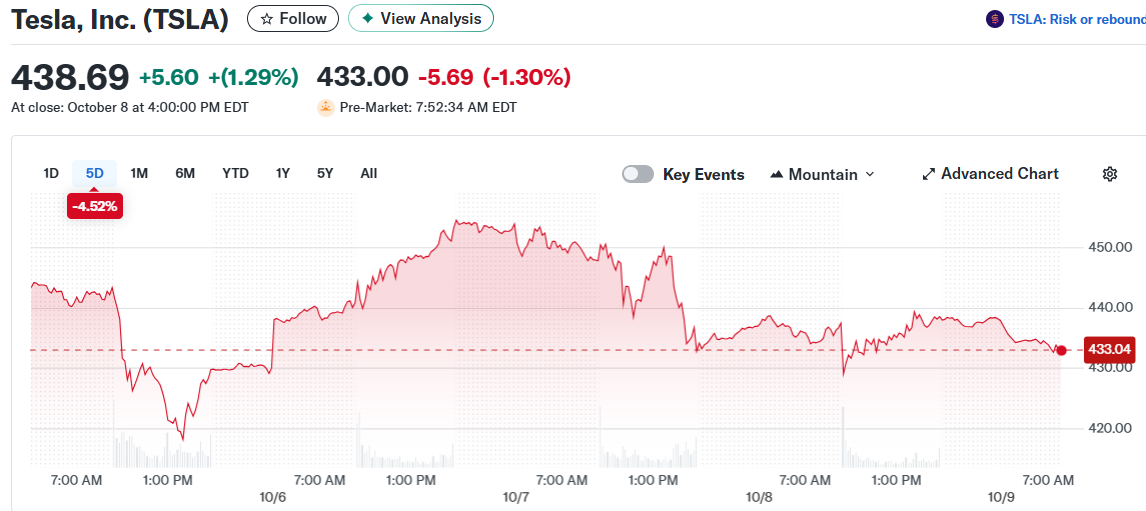TLDR
- Tesla’s new $878 billion compensation package for Elon Musk contains vague performance goals that could pay him tens of billions without revolutionary achievements.
- Standard Model 3 and Model Y variants launched at $36,990 and $39,990 with Full Self-Driving hardware included to expand the Robotaxi-ready vehicle fleet.
- Musk could earn $26 billion by hitting just two easier targets with modest stock growth, more than the next eight top CEOs combined.
- Vehicle sales goals require only 1.2 million annual units despite Tesla selling 1.7 million in 2024, while product goals use non-standard industry definitions.
- Tesla delivered a record 497,100 vehicles in Q3 2025, up 7% year over year, though production lagged at 447,450 units during the period.
Tesla introduced Standard versions of its Model 3 and Model Y this week. The vehicles start at $36,990 and $39,990 respectively.
Both models include Tesla’s Full Self-Driving hardware platform. Customers can activate the feature through a subscription. Each vehicle offers over 300 miles of range per charge.

The launch follows Tesla’s record Q3 2025 deliveries of 497,100 vehicles. That represents a 7% increase from the previous year. Production reached 447,450 units during the quarter.
Standard Model Y deliveries begin in November to December 2025. Standard Model 3 deliveries start in December 2025 to January 2026.
The pricing comes after the $7,500 federal electric vehicle tax credit expired on September 30. Tesla aims to reverse falling sales with these lower entry points.
Compensation Package Breakdown
The Tesla board proposed an $878 billion pay package for CEO Elon Musk in September. Directors claimed he would need to achieve “Mars-shot milestones” to earn the full amount over 10 years.
A Reuters analysis reveals Musk could collect over $50 billion without meeting most targets. Hitting just two easier goals with modest stock growth would net him $26 billion.
That surpasses the combined lifetime earnings of the next eight highest-paid CEOs. The group includes Mark Zuckerberg, Larry Ellison, Tim Cook, and Jensen Huang.
Four automotive experts called Musk’s vehicle sales goals “exceptionally easy to achieve.” Selling 1.2 million cars annually over the next decade earns him $8.2 billion in stock if Tesla’s market value grows from $1.4 trillion to $2 trillion by 2035. Tesla sold 1.7 million vehicles in 2024.
Product development goals use language that could allow major payouts without profit increases. Six robotics and autonomous-driving experts reviewed the goals for Reuters.
One target requires 10 million Full Self-Driving subscriptions. The goal doesn’t require full autonomy, only an “advanced driving system.” William Widen, a University of Miami law professor, called this a “made-up term” with no industry-standard definition.
Experts say Tesla could meet this by dropping the current $8,000 upfront or $99 monthly price. China’s BYD offers a similar system for free.
Vague Robot and Robotaxi Goals
Another goal requires one million robotaxis in commercial operation without a human driver in the vehicle. Four autonomous-vehicle experts said this could allow humans controlling vehicles remotely or from the passenger seat.
Tesla currently uses this approach in its Austin, Texas robotaxi test.
The robot target requires one million robots but doesn’t specify “humanoid.” It defines “bot” as “any robot or other physical product with mobility using artificial intelligence.”
Christian Rokseth, an analyst with Humanoid.guide, called the definition “totally vague.”
Hitting any two product goals plus a $2.5 trillion valuation pays Musk $26.4 billion. Three targets and a $3 trillion valuation pays $54.6 billion.
Musk’s hardest targets involve profit. Directors set eight profit goals between $50 billion and $400 billion in earnings. Tesla’s 2024 earnings were $16.6 billion.
Tesla’s valuation could reach $2 trillion with 6.4% annual share growth. That’s slower than the S&P 500’s 8.5% annual average over 30 years.
Seth Goldstein, a Morningstar analyst, said Tesla’s valuation could easily hit $3 trillion with market-average performance. The company’s value is already based on “future products that don’t exist today.”
Tesla shares trade at more than 250 times earnings. Lower-cost models could pressure profit margins while expanding the potential Robotaxi fleet.


